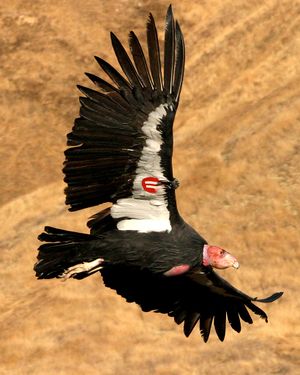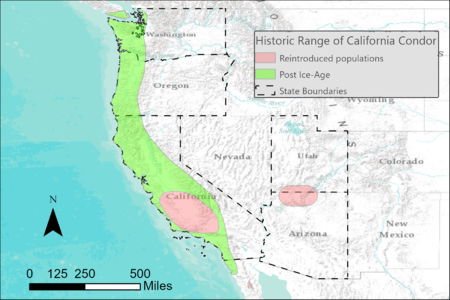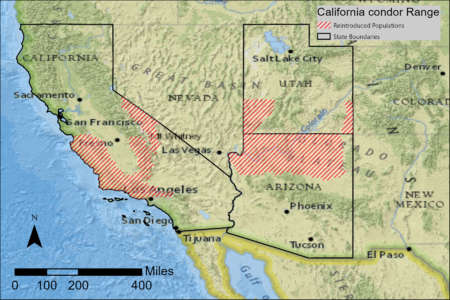California Condor
A species summary by the ENVS 560/L Watershed Systems class at CSUMB.
Classification
| Kingdom | Animalia |
| Phylum | Chordata |
| Class | Aves |
| Order | Cathartiformes |
| Family | Cathartidae |
| Genus | Gymnogyps |
| Species | G. californianus |
Life History
The California condor (Gymnogyps californianus) (CC) is the largest of the North American vultures and also the largest soaring land bird of the continent[1]. CC are thought to live up to 60 or 70 years. Like many other long lived species, CC reach sexual maturity later in life. Age of first successful breeding is thought to be between 6-8 years, with some 5 yr females laying infertile eggs in captivity[1]. Young condors usually stay in their natal home range for a year after they fledge and are dependent on their parents during this time. Home ranges include mountainous areas that serve as roosting and nesting sites, as well as lower elevation foothills that serve as foraging grounds. Young adult and immature condors that are nonbreeding tend to be more transient, not staying within a defined home range[1].
CC breed in pairs and can remain in breeding pairs on a multiyear basis. New pair formation occurs in late fall and early winter. Pairs produce single-egged broods between January and April. Incubation averages 57 days and eggs hatch between March and June. Fledging occurs 5-6 months after hatching and dependence on parents continues for another 6 months[1].
Habitat
Historical range
Historical records and remains indicate that the CC was once found across the United States, as well as southern Canada and northern Mexico.[1] By the mid-20th century the CC was largely confined to southern California. However, due to conservation efforts the CC is now found in the Big Sur Region and once again in Arizona, Mexico, and southern Utah.
Requirements
As the historical range of CC alludes, the species is capable of adapting to various habitats and climates. Notwithstanding, reliable air movement has been identified as a driver in habitat selection. Due to the large size of the CC, uplift plays a role in the species ability to take flight. CC uses thermal winds for foraging, and although the CC is surprisingly agile on the ground, they prefer to soar several hundred meters above it[1]. Unlike Turkey Vultures, which use their heightened sense of smell to locate carcasses, the CC uses its keen eyesight. Because they use eyesight to find carcasses they prefer to forage in open habitats, such as grasslands, montane grasslands, non-dense woodlands, and coastlines[1]. Presence of adequate food is also an important driver of CC habitat selection. Using thermal winds they will soar through the air for hours searching for carcasses or other scavengers who have found a meal, then using their large size dominate the competition[1].
Though the CC utilizes open areas for foraging, nesting and roosting can take place 40km away in higher elevation scrubby chaparral, forest montane, cavities within coastal redwoods and giant sequoias, and overhung ledges on cliffs. Key characteristics tend to be cover from the elements and slopes that allow for easy approach from the air[1].
Diet
The diet of the CC consists mainly of mammalian carrion, however, the occasional bird and reptile remains have been found in nests. CC historically fed on dead deer, ground squirrels, and other wild game, but as people encroached on their range extirpating species they shifted their diets toward domestic animals. Today, the diet of CC ranges from cattle, sheep, and horses, to deer, ground squirrels, and marine mammals that wash up along the coastline[1].
Conservation
The California condor (CC) had been in precipitous decline by the time the decision to bring the last remaining wild condors into captivity was made, in 1987. At that time, there were 27 adult CCs left on the planet, all in captivity[1]. Their decline started after the ice-age and is attributed to the die-off of mega-fauna, for which they fed on. As the decline continued their range shrunk and the species was found along the Pacific coast from British Columbia to Baja California[2]. Their decline would later be exasperated as Europeans colonized the Americas and overharvested deer, elk, and bison. In addition, westward expanding Americans viewed the CC as a nuisance and routinely harassed, poisoned, and shot them[1].
In 1967, 20 years before the CC was brought into captivity, it was placed on the federal endangered species list, with protections provided under the Endangered Species Act (ESA). Four years later the species was added to the California endangered species list and received additional protections under the California Endangered Species Act. Despite the population growing in the last 35 years, the species is also listed by the International Union for Conservation of Nature (IUCN) as critically endangered[3].
Most conservation efforts in the 20th century focused on habitat conservation, but this had little effect on the species declining population[1]. After the CC was listed under the ESA, mortality factors were studied. Lead poisoning has been identified as the leading cause of mortality for CC outside of captivity. This is due to lead ammunition fragments found in the flesh of carcasses the CC feeds on[2]. A lead fragment the size of a fingernail clipping is enough to kill a CC[1].
California Condor Recovery Program
California condor (CC) recovery has extensively focused on captive breeding, releasing captive-breed condors into the wild, and legislation focused on the ban of lead ammunition throughout their existing range. The current lead non-profit organization on the Central Coast for the recovery of the CC is the Ventana Wildlife Society.
In 1987, the last CCs in the world were being kept at breeding facilities at the Los Angeles Zoo and the San Diego Wild Animal Park[4]. In 1988, the first CC chick breed in captivity hatched. With the success of the breeding program in California, the decision was made to expanded breeding efforts at the World Center for Birds of Prey in Boise, Idaho and at the Oregon Zoo’s Jonsson Center for Wildlife Conservation in Clackamas County Oregon. There are also two captive breeding pairs at the Chapultepec Zoo in Mexico City, Mexico[4].
The first releases of CC back into the wild took place in Jan of 1992[1] and as of 2019, the total world population of CCs was 518, 337 in the wild and 181 in captive breeding facilities. In 1997, the Ventana Wildlife Society released its first CC in Big Sur. The California Condor Recovery Program is in the final phase of recovery, focusing on the goal of self-sustaining populations[5]. The plan is to establish two geographically distinct self-sustaining populations, each with 150 birds and at least 15 breeding pairs[5].
Threats
The greatest threat facing the recovery of California condors is the use of lead ammunitions for hunting. Lead poisoning is the number one cause of death for California condors[1]. Lead fragments are ingested while feeding on carcasses of shot animals. Because the threat is so great there have been efforts to educate the public surrounding the dangers of lead ammunition to wildlife. In 2008, the state of California banned the use of lead ammunitions in areas known to have condors, and in 2013 the state signed AB711, a law to ban all hunting with lead ammunitions. Despite the ban of lead ammunitions for hunting, lead ammunitions can still be purchased and the ban is reliant on public compliance[1].
Other threats to CC are microplastics[5]. CC are curious birds and will find and eat trash. Habitat modification is also identified as a threat to the species, specifically, wind energy and powerlines. California condors are trained in captivity to avoid powerlines, before release[5].
Partners in Condor Recovery
Partners in condor recovery include the United States Forest Service (USFS), National Park Service (NPS), Ventana Wildlife Society, United States Bureau of Land Management (BLM), Arizona Game and Fish Department, California Department of Fish and Wildlife (CDFW), Utah Department of Fish and Wildlife, the federal government of Mexico, the Yurok Tribe, San Diego Zoo, Los Angeles Zoo, Oregon Zoo, Santa Barbara Zoo, Chapultepec Zoo, The Peregrine Fund, and a host of other governmental and non-governmental organizations[5]. The Conservancy for the Range of the Condor is seeking to establish the Range of the Condor National Heritage Area.
Links
- Ventana Wildlife Society
- Special Status Animals in California's Central Coast Region
- Range of the Condor National Heritage Area
- Maps relating to the proposed Range of the Condor National Heritage Area
- Release Sites for the California Condor
- Map of California Condor Release Sites
- The Condor Trail
- California Condor Recovery Plan, Third Revision
- California Condor (Gymnogyps californianus) 5-Year Review:Summary and Evaluation
References
- ↑ 1.00 1.01 1.02 1.03 1.04 1.05 1.06 1.07 1.08 1.09 1.10 1.11 1.12 1.13 1.14 1.15 1.16 Finkelstein M, Kuspa Z, Snyder NF, Schmitt NJ. California Condor (Gymnogyps californianus). Birds of the World. 2020 Mar 4 [accessed 2021 Feb 28]. https://birdsoftheworld.org
- ↑ 2.0 2.1 [NPS] California Condor Reintroduction & Recovery (U.S. National Park Service). [accessed 2021 Mar 4]. https://www.nps.gov/articles/california-condor-recovery.htm
- ↑ [IUCN] Gymnogyps californianus (California Condor). International Union for Conservation of Nature. [accessed 2021 Mar 5]. https://www.iucnredlist.org/species/22697636/181151405
- ↑ 4.0 4.1 [CDFW] California Condor. California Department of Fish and Wildlife [accessed 2021 Mar 5].https://wildlife.ca.gov/Conservation/Birds/California-Condor
- ↑ 5.0 5.1 5.2 5.3 5.4 [USFWS] Myatt J, Myatt J. Pacific Southwest Region | California Condor Recovery Program. U.S. Fish and Wildlife Service [accessed 2021 Mar 6]. https://www.fws.gov/cno/es/CalCondor/Condor.cfm
Disclaimer
This page may contain student work completed as part of assigned coursework. It may not be accurate. It does not necessary reflect the opinion or policy of CSUMB, its staff, or students.


